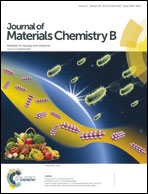Imidazolized magnetic nanovectors with endosome disrupting moieties for the intracellular delivery and imaging of siRNA†
Abstract
The development of a synchronized delivery and imaging system for small interfering RNA (siRNA) is required for the clinical application of RNA interference (RNAi) in cancer treatment. Herein, we report a pH-responsive, magnetic nanoparticle-based siRNA delivery system that can facilitate the safe and efficient delivery and visualization of therapeutic siRNA by high-resolution magnetic resonance (MR) imaging. Cationic poly-L-lysine-graft-imidazole (PLI) with a reactive silane moiety was stably immobilized onto the surface of the assembled manganese ferrite nanoparticles (MFs) through an emulsion process, ensuring high water solubility, enhanced MR contrast effect, and endosome-disrupting functionality. The synthesized nanovectors were then complexed with siRNA targeting the CD44 gene via electrostatic interactions to verify the specific gene-silencing effect. The imidazolized magnetic nanovector (ImMNV) architectures developed here facilitated improved cellular internalization and exhibited a high level in vitro downregulation compared to non-imidazolized MNVs in metastatic breast cancer cells.


 Please wait while we load your content...
Please wait while we load your content...